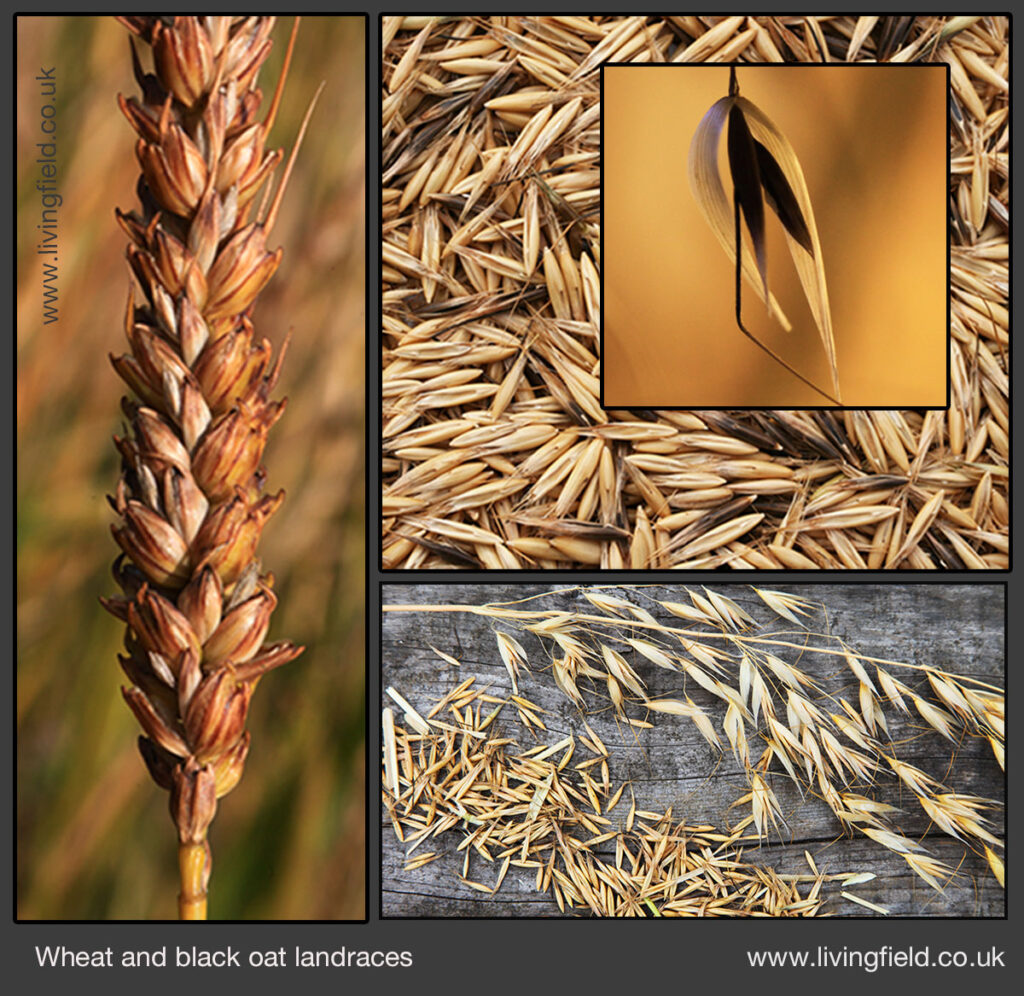For many years the Living Field garden near Dundee grew a range of ancient (and modern) cereals, partly for interest and partly to show people what used to be grown and eaten in the northern croplands.
Now the garden is no longer in operation, the editor misses the wonderful cereal diversity that used to be on show. So a small patch in a vegetable garden, just 2 m by 1 m, was sown with old saved seed at various times in April this year.
Most of the cereal species or varieties emerged quickly and in numbers, but a few took more time and some hardly germinated. For example, only one seed of Shetland bere barley germinated (saved from 2015), but that single plant went on to produce many ears.
Here’s some photographs taken in August 2022.
Spratt barley
A favourite, its distinct two rows on a curvy ear with very long awns. It germinated, grew and formed ears quickly, and was maturing by mid-August.
The Lawsons’ seedsmen [1], writing in the mid-1800s, classed it as a distinct type, different from two-row and four- to six-row barleys. They also named it fan or battledore. You can see the likeness to a fan, less so to a battledore – an oval paddle used to wash and beat clothing or a racket used with a shuttlecock.

Emmer wheat
Emmer Triticum dicoccum was one of the first cereals to be domesticated in the fertile crescent. It is no longer grown commercially in the north but emmer flour is still available from specialist merchants.
It was the slowest of all the seedlings to grow and last to put out its head or spike. By mid August the plants had reached 5 feet in height (1.5 m) each with many grains, still maturing in the hot, sunny days.

Black or bristle oat
Black oat Avena strigosa is a different species from the common oat cultivated today. It was grown widely as a livestock feed and still remains as a feral plant in some areas, gone wild.
It grows very quickly, the first to flower and set seed, most of it mature in less than three months. Where other grain crops might fail, at least black oat would give some straw and grain. The seeds are long, thin and hard, so not a people’s favourite – though it was dubbed “famine food”, eaten when all else ran out.

Rye
Rye Secale cereale has not been grown in the north on the same scale as oats and barley. Yet it germinates quickly and grows to heading not far behind black oat. The heads, or ears, are upright at first (lower left in the photographs below). Awns are much shorter than those of spratt or bere barley. As the ears mature, the awns splay out, the grains become visible (lower right) and the whole ear forms a gentle curve (upper right). The naked grains, around 5 mm long (upper left), are easy to extract simply by rubbing the ear between fingers.
Bere landraces
Bere – a landrace of barley – is rare now in Scotland but was grown over most of the country as recently as the 1850s. It was recorded as distinct from barley in the annual agricultural record in the early 20th century, but is now confined to a few fields in Orkney.
The Living Field has grown bere for years, seed saved over each winter and sown the next spring. Some early records show a similar landrace was grown in parts of north west Europe, suggesting the bere landraces were not solely Scottish. Links to previous Living Field articles are given at The bere line – rhymes with hairline and Bere barley at the Living Field.
The grains are pale green during early filling (lower left in the panel), but become darker streaked with red. They are protected by many long bristly awns, which did not quite succeed in keeping small birds from taking the grains.
[more to be added]
Sources | links
[1] Lawson, Peter and Son. MDCCCLII (1852) Synopsis of the Vegetable Products of Scotland. Edinburgh: private press of Peter Lawson and Son.







